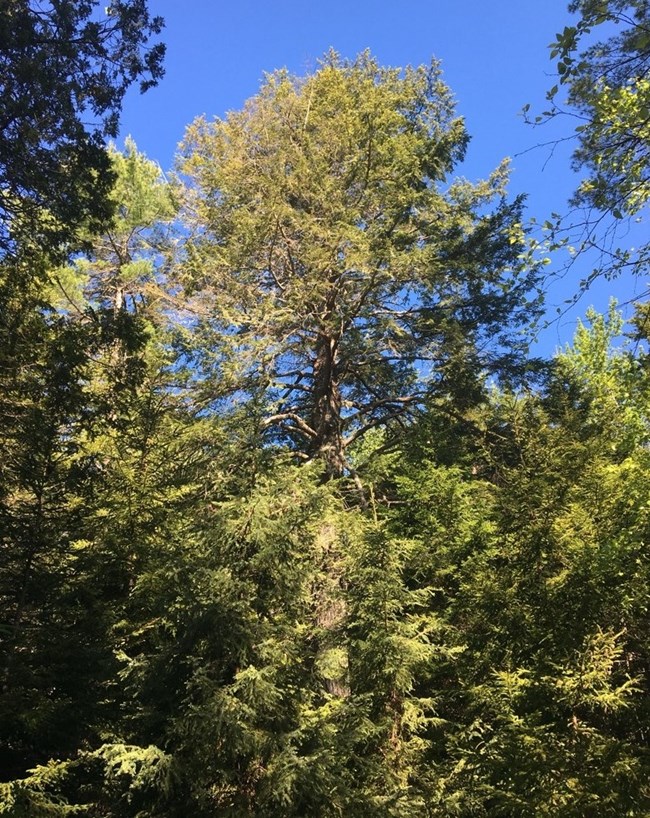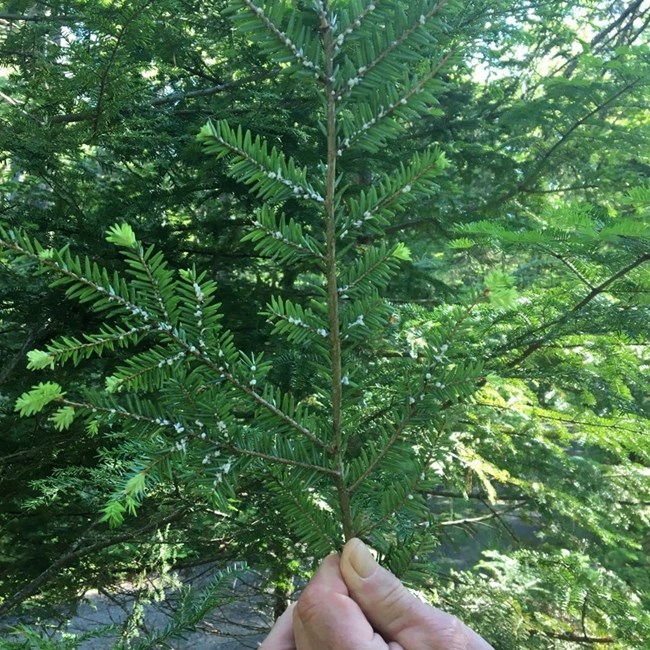Last updated: October 8, 2021
Article
Hemlock Woolly Adelgids: A New Threat to Acadia

NPS Photo
By Sophia Cameron, Invasive Plant Management Intern and Jesse Wheeler, Vegetation Program Manager
When a concerned resident of Mount Desert Island reported a sighting of what they believed to be the dreaded Hemlock Woolly Adelgid (HWA) to the Maine Forest Service in May 2020, the responding entomologist confirmed the invasive insect among forest hemlock trees spread among several acres. This small, invasive pest has wreaked havoc in the forests of the eastern U.S. and Canada, damaging eastern hemlock (Tsuga canadensis) populations, and in turn affecting entire ecosystems. Here you’ll find what you need to know about HWA, and what you can do to help keep our local ecosystems safe and healthy.
Species Profile
The hemlock woolly adelgid (Adelges tsugae) are non-native, invasive, aphid-like insects. Their life-cycle consists of an incomplete metamorphosis, in which they grow from eggs to crawlers, and finally to adults, with two generations a year. All life stages are small, and very difficult to spot. In the northeast, the adults are asexually reproducing females who do not have wings. They are transported from tree to tree via wind or animal transportation, and lay their eggs of the young twigs and branches of hemlock trees. Once the eggs hatch, the first mobile instars are produced, which are also referred to as crawlers. These are what do the most damage to eastern hemlocks, since they require the sap of the tree to grow. To do this, they feed on the new branches and twigs of the trees during the winter and early spring. This prevents the trees from producing new leaves in the late spring and summer and eventually leads to the death of the tree. The egg sacs of HWA are the easiest to spot and appear to be small, round, woolly orbs on the underside of the needles of eastern hemlock trees.

NPS Photo
Origin of HWA
HWA is an Asian insect, most likely introduced to the U.S. accidentally. The first recorded sighting of it was in Virginia and Southern Pennsylvania in the 1960s, however, it did not become a recognized problem until around the 1980s. It now ranges from Georgia to Maine. Reported locations are just a rough estimate of their spread since they are difficult to spot. It has also been confirmed in the Pacific Northwest; however, they have not posed as significant a threat there, since they infect western and ornamental hemlock, which seem to be more resistant.
How does it affect ecosystems?
HWA spreads from tree to tree by hitching a ride on arboreal species of birds and mammals as crawlers. Adults have been found to remain on and around the tree from which they hatched. Although they do not directly affect vertebrates, their destruction of hemlock does have a large impact on them.
Eastern hemlocks tend to grow along or near freshwater streams, ponds, and lakes. Those that grow along the edge of these bodies of water play a very important role in the ecosystems that exist within them. During the hot spring and summer months, the hemlocks maintain cooler, more constant water temperature by providing dense cover from the sun. This creates an ideal environment for small freshwater invertebrates., and cold-water fish. These invertebrates are the major food source for the many different species of freshwater fish that we have here at Acadia, such as brook trout. So, when the hemlocks eventually die from an HWA infestation, the invertebrates can no longer thrive there, and we see a decrease in freshwater fish populations. This of course causes even more issues going up the food chain, so that one tiny insect is affecting an entire ecosystem.
How can we control HWA?
Since HWA is non-native, they also currently do not have any effective biological controls native to North America—such as predation—to keep their populations in check. Several introduced species have been proposed in different states; predator beetles have been introduced in the northeast, but it seems as though they are unable to keep up with the adelgid spread. Cornell University in Ithaca, New York has been conducting ongoing research to determine the exact timing of metamorphoses to decide the best course of action for treatment. Most resources on HWA agree that removing infested branches during the dormant season of August – February is the best method. This is difficult, however, because it would involve checking every branch on every hemlock tree in affected areas, which is time consuming and nearly impossible. HWA can be distributed at throughout the tree, and since eastern hemlocks are known for growing to great heights, it would require special training to check and remove branches from the tops of the trees.
At Acadia, the Invasive Plant Management Team (IPMT) are responding to calls of any sightings of HWA near park land. As of now, we are not treating for HWA, but are instead continuously monitoring. We are also recording areas with dense stands of eastern hemlocks as well, so that when HWA becomes a bigger issue we know where in the park to look for it and to identify important hemlock to protect.
If you believe that you have found HWA on your property, please contact Jesse Wheeler before removing and destroying any branches, as well as the Maine Forest Service. If you see HWA on or near park land, please contact the Acadia IPMT at the email or phone number listed below.
Contact Information:
Jesse Wheeler
e-mail us
207-288-8722
Maine Forest Service
https://appengine.egov.com/apps/me/dacf/mfs-tree-ailment
207-287-2791
University of Maine Cooperative Extension Pest Management (for concerns at private residences)
207-581-3880
extension.diagnosticlab@maine.edu
References
McClure, Mark S. 1987. “Biology and Control of Hemlock Woolly Adelgid,” Connecticut Agricultural Experiment Station: Bulletin 851.
McClure, Mark S. 1990. “Role of Wind, Birds, Deer, and Humans in the Dispersal of Hemlock Woolly Adelgid (Homoptera: Adelgidae).” Environmental Entomology 19 (1): 36–43. https://doi.org/10.1093/ee/19.1.36.
Orwig, David A., and David R. Foster. 1998. “Forest Response to the Introduced Hemlock Woolly Adelgid in Southern New England, USA.” The Journal of the Torrey Botanical Society 125 (1): 60–73. https://doi.org/10.2307/2997232.
